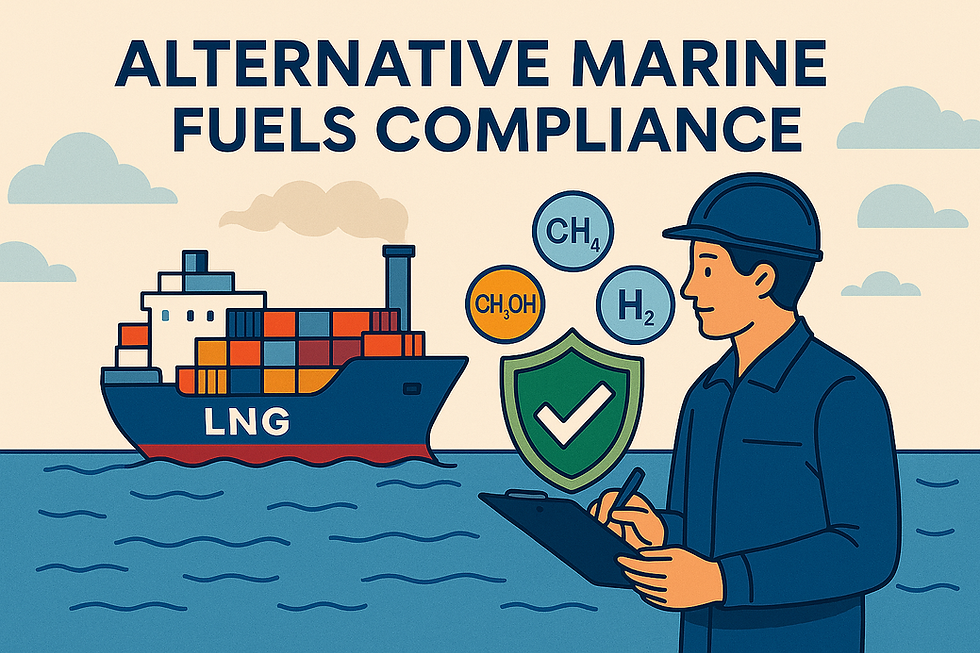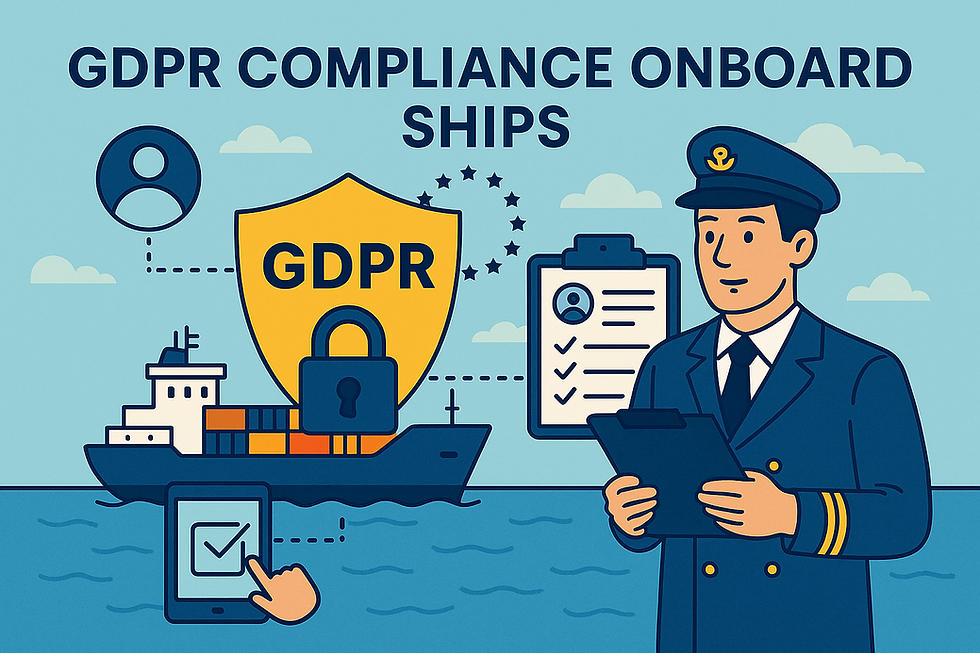⚗️ Alternative Marine Fuels: How to Navigate Regulatory Compliance for LNG, Methanol, and Hydrogen
- Davide Ramponi

- 18. Juli
- 5 Min. Lesezeit
My name is Davide Ramponi, I’m 20 years old and currently training as a shipping agent in Hamburg. On this blog, I take you with me on my journey into the exciting world of shipping. I share my knowledge, my experiences, and my progress toward becoming an expert in the field of Sale and Purchase – the trade with ships.

Today’s topic is one that blends innovation, environmental pressure, and technical complexity: alternative marine fuels. As the industry faces growing pressure to decarbonize, shipowners are increasingly exploring fuels like LNG, methanol, and hydrogen.
But here’s the catch: with innovation comes regulation.
So what safety and environmental standards apply to these fuels? How do ships and ports stay compliant? And what does the future hold for fuel regulations as we enter the era of low- and zero-emission vessels?
Let’s set a course through the compliance maze before your next retrofit or newbuild leaves the yard. 🌍⚓
🌱 Why Alternative Marine Fuels Matter—and Why They’re Regulated
The maritime industry is under increasing pressure to reduce greenhouse gas (GHG) emissions. Regulations like the IMO’s Initial GHG Strategy, the EU ETS, and the FuelEU Maritime package are driving rapid change.
🚢 Key Alternative Fuels in Focus:
LNG (Liquefied Natural Gas)
Methanol (CH₃OH)
Hydrogen (H₂)
Each promises lower emissions—but also comes with technical risks, safety challenges, and regulatory obligations.
📌 Bottom line:
Using alternative fuels means meeting new standards—not just in engine tech, but in safety, crew training, infrastructure, and documentation.
🔍 Safety & Environmental Standards: What the Rules Say
Let’s break it down by fuel type.
1. LNG (Liquefied Natural Gas)
✅ Lower CO₂ and NOₓ emissions than HFO or MGO
❗ Still a fossil fuel with methane slip concerns
🚨 Highly flammable and stored at –162°C
Compliance Framework:
IMO IGF Code (International Code of Safety for Ships Using Gases or Other Low-Flashpoint Fuels)
SOLAS Chapter II-1 & II-2 for fire and explosion protection
Flag state regulations and class society guidelines
2. Methanol
✅ Reduces SOx and particulate matter emissions
✅ Can be produced renewably
❗ Toxic if ingested or inhaled, low flashpoint
Compliance Framework:
IGF Code, with specific addenda for alcohol-based fuels
ISO 22241 for fuel quality
Port state requirements for methanol bunkering (varies by country)
3. Hydrogen
✅ Zero-carbon fuel (if produced via electrolysis)
❗ High flammability, very low ignition energy
❗ Cryogenic storage or compression presents major engineering challenges
Compliance Framework:
Draft IMO Interim Guidelines for Hydrogen (being refined by MSC)
IGF Code under revision to cover H₂ more extensively
Local pilot regulations in places like Japan, Norway, and the Netherlands
💡 Tip:
Hydrogen compliance is evolving fast—consult your flag and class societies during the design phase.
🛠️ Certification and Technical Standards Required
New fuels mean new certifications—for vessels, ports, and personnel.
🚢 For the Vessel:
Low-flashpoint fuel compliance certificate (under IGF Code)
Fuel system drawings and risk assessment
Updated Stability and Fire Control Plans
Approval from classification society (e.g., DNV, LR, ABS)
👨✈️ For the Crew:
Training in hazard identification and emergency procedures
Familiarity with fuel-specific PPE and bunkering systems
ISM amendments to Safety Management Systems (SMS)
⚓ For Ports:
Port facility must be certified for safe bunkering operations
Must have fire suppression, spill control, and emergency response plans
📋 Checklist culture is key. Don’t let a missing permit delay operations or void insurance coverage.
🧱 Infrastructure and Onboard Requirements: What Must Be in Place?
Fuel is just the beginning—the real challenge lies in infrastructure and integration.
⚓ Port Infrastructure Must Include:
Bunkering arms or hose transfer systems
Leak detection and vapor recovery units
Emergency shutdown systems (ESD)
Trained personnel for hazardous fuel handling
🚢 Onboard Systems Must Cover:
Double-walled piping and tanks
Explosion-proof sensors and control panels
Fuel management software
Crew protection: gas detectors, PPE stations, ventilation systems
🧠 Tip:
Consider a hybrid fuel setup (e.g., dual-fuel engines) to allow operational flexibility during early adoption.
⚠️ Practical Challenges: From Theory to Dockside Reality
Going green isn’t plug-and-play. Here’s what owners and operators are dealing with:
🔧 Technical:
Retrofitting existing vessels can be complex and costly
Hydrogen systems still lack global standardization
Methanol compatibility varies across engine types
💸 Financial:
CapEx for LNG/hydrogen-ready ships is 10–30% higher
Crew training and infrastructure costs can be hard to budget
Fuel price volatility and supply uncertainty
🌐 Operational:
Limited bunkering availability in many regions
Complex cross-border regulatory differences
Risk of fuel quality inconsistencies without harmonized ISO specs
💬 Lesson:
Adoption is as much a management decision as it is a technical one.
🔮 What’s Coming Next: Future Regulations on the Horizon
Alternative fuels are not just a trend—they’re central to the maritime future. Expect stricter rules and expanded oversight in the coming years.
📅 Regulatory Developments to Watch:
IMO Revised GHG Strategy (2023–2030):
Carbon Intensity Indicator (CII) enforcement
Fuel lifecycle emissions to become key metric (Well-to-Wake)
EU FuelEU Maritime (2025):
Sets GHG intensity limits for marine fuels
Applies to all ships >5,000 GT calling at EU ports
ISO 8217 & 8216 Updates:
New specs for biofuels, hydrogen blends, methanol grades
Green Corridors:
Bilateral and regional emission-controlled zones with specific fuel requirements (e.g., Rotterdam–Singapore corridor)
🚨 Warning: Non-compliance with future fuel rules could mean denial of port access, penalties, or charter rejections.
🧭 Best Practices for Ensuring Fuel Compliance
Here’s how to stay ahead of the curve:
✅ Plan from Day One
Involve class societies and flag states at design stage
Choose fuels with supply chain and port access in mind
Build modular systems that allow fuel flexibility
📘 Update Documentation
Revise the SMS to include alternative fuel procedures
Maintain bunkering logs, training records, and system schematics
Document all risk assessments and crew drills
🧠 Train Continuously
Use e-learning and simulator-based fuel handling programs
Include emergency drills for fire, leaks, and bunkering errors
Stay current with flag state advisories and IMO circulars
🤝 Collaborate with Ports and Charterers
Coordinate bunkering schedules and fuel compatibility checks
Ensure charterparty clauses reflect fuel type obligations
Stay informed about local safety regulations and certifications
📚 Real-World Example: Dual-Fuel Tanker in the Med
A Greek owner recently launched a methanol-ready MR tanker, certified under DNV with IGF Code compliance. Despite technical success, the vessel initially faced delays at Spanish ports due to unclear methanol bunkering rules.
📈 Solution:
Engaged port authorities early
Shared safety protocols and risk assessments
Trained local fire teams to support methanol handling
💬 Result:
Vessel cleared to operate with full compliance and positive media attention.
🧰 Compliance Checklist: Alternative Fuel Readiness
Use this summary before commissioning or bunkering a non-conventional fuel vessel:
🔎 Certification
☑️ IGF Code compliance certificate
☑️ Fuel-specific risk assessment
☑️ SMS and ISM updated
⚙️ Technical Systems
☑️ Approved storage and transfer systems
☑️ Gas detection and ventilation
☑️ Emergency shutdown tested
👨✈️ Crew and Operations
☑️ Fuel training certificates
☑️ PPE and response drills
☑️ SOPEP or SEEMP Part III updated
📑 Documentation
☑️ Bunkering checklists and permits
☑️ Maintenance logs
☑️ Safety datasheets onboard
📌 Final Thoughts: Green Fuels Need Smart Compliance
Alternative fuels are the future of shipping—but without regulatory readiness, even the cleanest fuel can become a risk. By investing in compliance now, you’re not just avoiding fines—you’re future-proofing your fleet and protecting your reputation.
🎯 Key takeaways:
LNG, methanol, and hydrogen require specific equipment, training, and documentation
Compliance begins at design and continues through daily operations
Global regulation is evolving fast—stay ahead by preparing today
Coordination with ports, class, and crew is essential for safe, compliant adoption
Have you already implemented an alternative fuel strategy on board? What challenges—or successes—have you encountered?
💬 Share your thoughts in the comments — I look forward to the exchange!





Kommentare